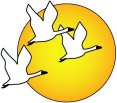 National and International
Suicide Prevention Organizations
National and International
Suicide Prevention Organizations
American
Association of Suicidology
AAS promotes research, public awareness programs, public education,
and training for professionals and volunteers. In addition,
AAS serves as a national clearinghouse for information on suicide.
AAS holds national conferences for professionals and survivors
of suicide, as well as other trainings and services; offers
certification to crisis centers; and has many useful publications.
American Foundation
for Suicide Prevention
The American Foundation for Suicide Prevention is dedicated
to advancing the knowledge of suicide and our ability to prevent
it. The Foundation’s activities include: providing information
and education about depression and suicide; promoting professional
education; publicizing the need for research, prevention, and
treatment; and supporting programs for suicide survivor treatment,
research, and education.
Befrienders
International
Befrienders International is a charity developing volunteer
action to prevent suicide in 41 countries worldwide and providing
information on the Internet. Their site features the world's
most comprehensive directory of “emotional first aid helplines.”
Centre for Suicide
Prevention (Canada)
Formerly Suicide Information and Education Centre
Suicide Prevention Education Programs
he Suicide Information & Education Centre (SIEC) is a special
library and resource centre providing information on suicide
and suicidal behaviour, focusing on Aboriginal groups.
Centre
for Suicide Research, University of Oxford
Research group investigating causes, treatment and prevention
of suicidal behavior.
International
Association for Suicide Prevention
IASP is dedicated to preventing suicidal behaviour, to alleviate
its effects, and to provide a forum for academians, mental health
professionals, crisis workers, volunteers and suicide survivors.
Kristin
Brooks Hope Center
Concrete information with steps to take if you are thinking
about suicide.
The
Link’s National Resource Center for Suicide Prevention
and Aftercare
The Link offers services for survivors who have lost a loved
one by suicide. The Aftercare Program includes support groups,
telephone counseling, grief counseling and consultation. Resource
materials and a bereavement newsletter, The Journey, are available.
The program also provides postventions for schools, businesses,
places of worship and anyone in the community needing support
and guidance after a suicide.
National Organization
for People of Color Against Suicide
NOPCAS was founded by three African-American suicide survivors.
Its goals are to bring suicide and depression awareness to minority
communities that have historically been discounted from traditional
awareness programs.
National
Suicide Prevention Resource Center
(Information from the Center is not yet directly available)
On Oct. 1, 2002, the Education Development Center was
awarded a $7.5 million grant over three years to help communities
implement suicide prevention programs. “The Center’s
primary goal will be to save lives by sharing best practices
in suicide prevention.” It will include a national project,
www.ncspt.org, to train public health professionals through
online workshops and other educational resources.
Organizations
of Attempters and Survivors of Suicide Interfaith Services
OASSIS enriches the lives of those who have been and
will be touched by suicide by increasing suicide awareness and
removing the stigma on attempters and survivors. OASSIS facilitates
educational programs, organizes systems-wide support, trains
professional caregivers, and offers consultative services.
The
Real World
Provides information about suicide and its prevention. It includes
frequently asked questions about suicide, essays, emergency
help, warning signs, statistics, international crisis resources
and annotated links to other suicide and related sites. The
simplistic yet stylish design of this site allows for easy
Suicide Awareness
Voices of Education
SAVE is committed to removing stigma associated with depressive
brain diseases (such as clinical depression and bipolar illness)
through education of the general public. SAVE’s billboard
campaign conveys two messages: Depression is a disease and untreated
depression can lead to suicide. The site has a great deal of
information about depression and suicide.
Suicide
and Parasuicide: The Suicidology Web
This site brings the latest subjects and resources related with
the study of the suicidal phenomena. It is specially designed
for health care professionals; Psychiatrists, Psychologists,
Suicidologists, Sociologists, Therapists and other mental health
practitioners and general health care providers. Offering a
great number of resources, based in the most accurate and reliable
sources available, it gathers important information useful for
those working in the field.
Suicide Prevention
Action Network USA (SPAN USA)
SPAN USA is dedicated to preventing suicide through grassroots
personal and community action grounded in best practices and
collaboration. The organization facilitates partnerships among
all who are dedicated to preventing suicide through proven,
effective programs at every level of society. SPAN USA is a
tremendous resource for individuals and communities striving
for change.
Suicide
Prevention Research Center
Serves the inter-mountain west region. CDC’s largest
national extramural investment in suicide prevention research
and training. The center will identify, evaluate, develop, and
improve suicide interventions fro the prevention and control
of suicide-related injuries; and develop a regional suicide
surveillance system. Website slated for 2003. Please contact
Lynne Fullerton-Gleason, Ph.D., University of Nevada School
of Medicine, Suicide Prevention Research Center. E-mail: lfullerton@suicideprc.com.
Violence
and Injury Prevention Program
The Violence and Injury Prevention Program conducts research
to improve our ability to detect, intervene, and prevent suicide,
homicide-suicide, and homicide; trains professionals to detect,
intervene, and prevent these situations; provides traumatic
grief resources for family survivors; advocates for suicide
and related prevention.
